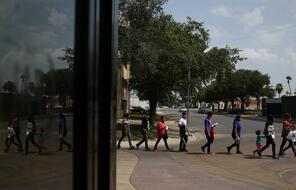Breadcrumb
Latino Americans: The 500-Year Legacy That Shaped a Nation
Subject
- Civics & Citizenship
- History
Language
English — USUpdated
Stream the Latino Americans Documentary Series
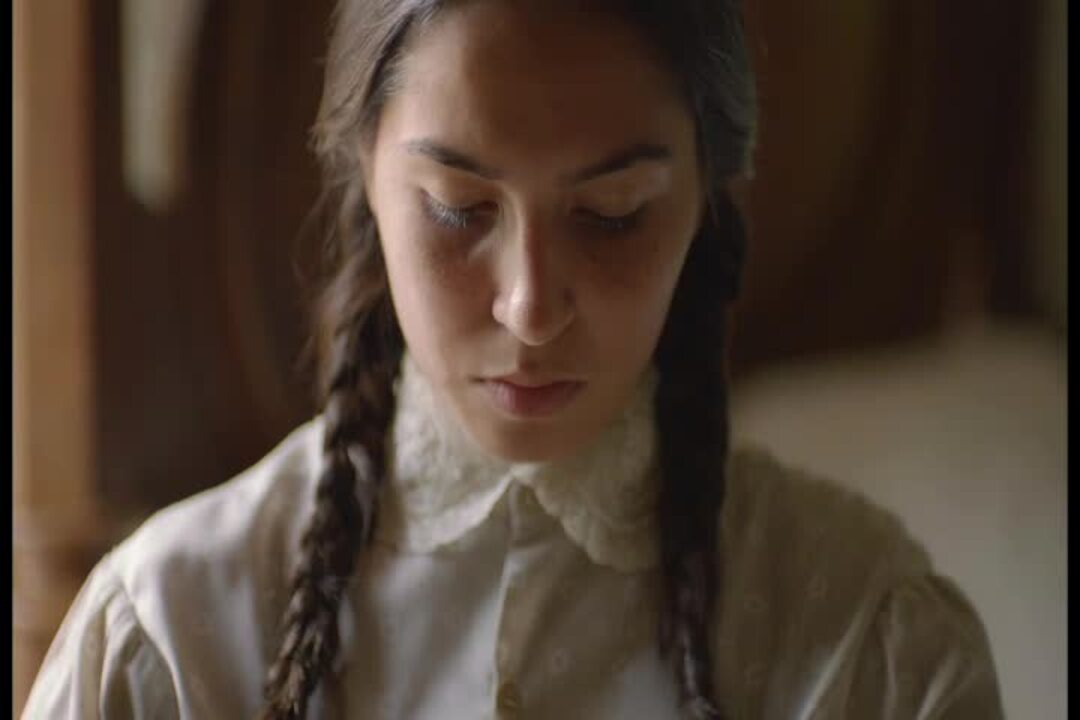
Foreigners in the Their Own Land (1565-1880)
Foreigners in the Their Own Land (1565-1880)
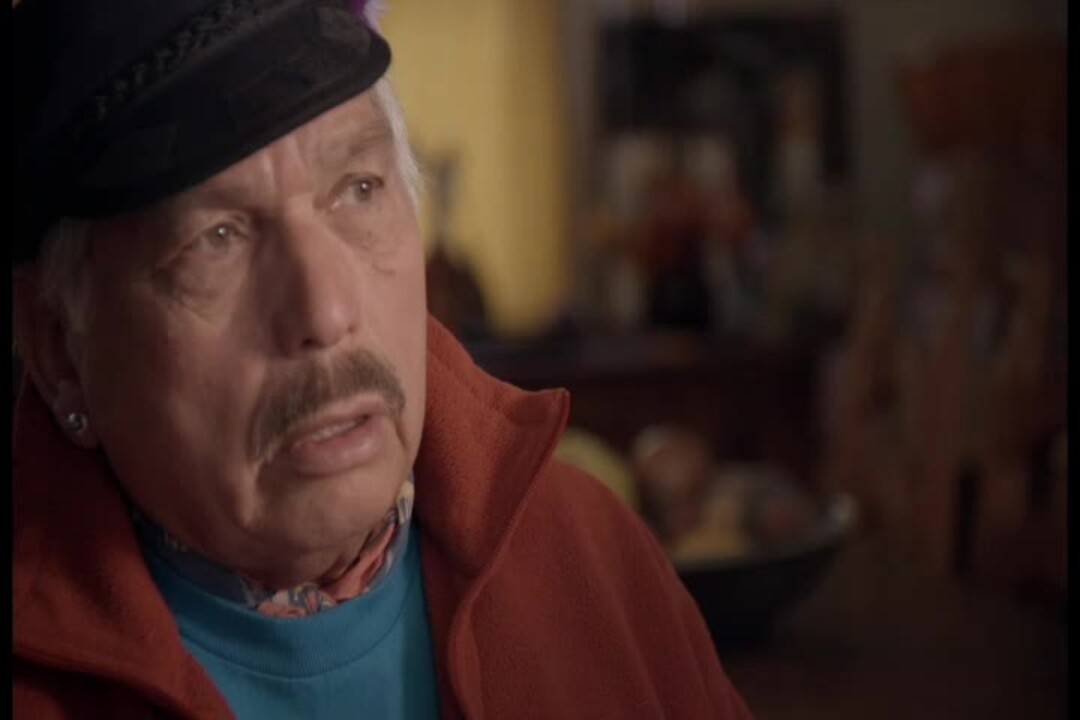
Empire of Dreams (1880-1942)
[MUSIC PLAYING]
Help everyone explore new worlds and ideas. Support your PBS station.
[MUSIC PLAYING]
From 1836 to 1914, over 30 million people immigrated to the United States. The tired huddled masses that made Ellis Island a beacon of hope. Among the crowded faces at New York Harbor in January 1880, was a 27-year-old political exile from Cuba, José Martí.
Elsewhere, they make men flee. But here, they welcome the fleeing man with a smile. Martí will join the earliest community of Latinos in New York, Puerto Ricans, and Cubans who had arrived along the trade routes that brought tobacco, coffee, and sugar into the US.
[TRAIN HOOTING]
As the new century dawned, many more Latinos would venture North from places linked to America by trade or taken by conquest.
This huge Latino presence in the United States is a direct result of our own nation's territorial expansion.
Tens of thousands would come from Puerto Rico.
[THUNDER RUMBLING]
An island acquired by war in 1898. They would build a community that in time would see more Puerto Ricans in the United States than on the island itself. Nearly 1 million would come from Mexico following the tracks that brought silver and copper to America. And now, provided the only escape from a violent revolution. Juan Salvador Villasenor survives the war and achieves his own version of the American dream.
My father thought that the United States was like paradise. There was food for everyone and there was jobs for everyone.
But for a Mexican American girl born in Los Angeles, that dream would be denied. Emilia Castaneda and her family are deported along with half a million Mexicans and Mexican Americans during the Great Depression.
We had a trunk, a big trunk. And the first thing my father put in there was his working tools, and a couple of blankets that we had. Because we lost everything.
It sets up a pattern of wanting Mexican labor at times in which employment is needed, and wanting people to just leave when that labor is no longer needed.
[MUSIC PLAYING]
Half a century after other Latin American countries achieved their independence, all that was left of Spain's vast American empire were the islands of Cuba and Puerto Rico. In 1868 angered by 300 years of Spanish rule, Cubans rose in revolt.
[SPEAKING SPANISH]
Inspired by the uprising, José Martí wrote his first poem at age 15.
[SPEAKING SPANISH]
Martí is a romantic, an idealist from a very young age, 15, 16 years old. He's already publishing a newspaper in Cuba advocating for independence.
José Martí was tried for treason and sentenced to forced labor when letters linking him to the revolt were found. The chains attached to his legs lacerated him so severely that his mother pleaded to have her son released. He was exiled from Cuba.
[MUSIC PLAYING]
For 10 years, he wandered the world and in 1880, the aspiring revolutionary arrived in New York.
Martí is venerated as the father of Cuban independence, a towering figure of Cuban history. His status in Latin America has this tremendous almost divine nature in many ways. But Martí, when he arrives in New York in 1880, is a 27-year-old poet.
He comes to the United States as many revolutionaries from the Americas did because it was a safe place to plot for the independence of his country.
[MUSIC PLAYING]
The dream of equality, the dream of freedom, that was the dream of the United States. That's what drew him to the United States.
I am at last in a country where everyone looks like its own master. Freedom being here the foundation, the shield, the essence of life.
America was intellectually free, dynamic, you didn't have Spanish agents looking over your shoulder if you wanted to publish a newspaper. It was a place where Martí could look over the fence and into an alternative view of what a society could be like.
Martí worked as a correspondent for leading South American journals, writing on every aspect of life in America. He reported on an amazing number of events.
[BLASTS]
He covered the opening of the Brooklyn Bridge, he covered the Haymarket Square affair, the executions, lynchings. It gave him enormous insight into American society.
The racism of the era of Jim Crow and the inequities of New York City in the age of the robber barons transformed José Martí.
[MUSIC PLAYING]
Once an admirer of the United States, he began to lose faith in America.
He becomes incredibly disillusioned and he begins to realize that the United States is not an appropriate model for the Cuba that he envisioned. He envisions a Cuba for people of all races, of all economic backgrounds.
It is around 1891 that he changes. He is no longer an observer, he now becomes a full time political actor. And there is a speech in which he essentially launches this. And he says, we are now going to get on our horses, figuratively, of course, because he really didn't ride a horse. Figuratively he says, we're going to get on our horses, and we shall now ride and we shall summon all our strength to be able to finally do what we have to do as Cubans.
[DRAMATIC DRUMBEAT]
From the safety of exile, Martí organized an insurrection and went to Key West and Ybor City near Tampa, where 15,000 Cubans had settled around cigar factories.
The cigar workers would pool their resources and hire a man to read to them during the workday. And that lector, that reader, would read newspapers, would read from novels and from plays. So consequently the workers were very informed people and politically savvy.
Contributing one day's pay each week to the cause of independence, cigar workers became the heart and soul of the revolution and devoted followers of José Martí. What a man, observed one worker. With each visit he lays one new brick to the building. Martí founded the Cuban Revolutionary Party and published a newspaper, Patria. On its pages, he warned of the threat he felt America's growing power represented for Latin America.
Unlike previous emigres who had tried to lobby the US to enter into the conflict, Martí does not want to call attention to the cause of Cuba in the US.
Martí believes that if left to its own devices, the United States would be an expansionist power. And look, he isn't too far off the mark. Twice in the 19th century, the United States tries to buy Cuba from Spain.
[DRAMATIC DRUMBEAT]
Martí knows his history. He sees what has happened to the people of Mexican origin, the conquered territories in the Southwest. He sees how despite the protections offered by the Treaty of Guadalupe Hidalgo, that the people in this conquered territory have become second class citizens.
[DRAMATIC DRUMBEAT]
BY 1895, Cuban rebels were ready to rise up. Martí wrote the order for the insurrection to begin. It was smuggled into Havana, hidden inside a cigar.
[MUSIC PLAYING]
In April, he sailed to Cuba with a small force of exiles to command the uprising. Only five weeks after he arrived, the poet was killed in battle. An unfinished letter published after his death would become his most important legacy.
"My dearest brother. I am daily in danger of giving my life for my country and duty. The duty of preventing the United States from overpowering our lands with its might."
[DRAMATIC MUSIC]
[RAPID GUNFIRE]
For the next three years, Cuban insurgents and Spanish soldiers fought a fierce war of attrition. 90 miles South of a mighty American nation poised to become a world power.
As it looks on a world of nations that is rushing to acquire colonies, the United States asks, should we join this race for expansion? And one sector of America says, yes, great nations have imperial territories. And then there's another group of Americans that says, well, not so fast. This nation was born to be a nation of equality and liberty. It was not born to impose its will and its sovereignty on unwilling people.
With the United States now extending from sea to shining sea, expansionist coveted the scraps of the Spanish empire. The Philippines, in the Pacific, and in the Caribbean, Puerto Rico. And Cuba strategic island at the gateway of the Gulf of Mexico, and where Americans had $50 million invested in sugar. But with 300,000 soldiers in Cuba, Spain was determined to hold on to the island.
To crush the insurgency and weaken support for the rebels, hundreds of thousands of Cubans were herded into concentration camps. Their plight became daily fodder for William Randolph Hearst and Joseph Pulitzer who beat the drums of war to build their newspaper empires.
What makes the enthusiasm for a war in Cuba almost unanimous in 1898 is that it offers a way for the United States to express both of its impulses. The impulse to make a statement to the world. We are an imperial power. And on the other hand, the opportunity to say we are bringing our heritage of liberty and freedom and democracy to people who want it.
With war fever running high, all that was needed was a pretext. On February 15, 1898.
[BLAST]
In Havana Harbor, an explosion destroyed an American battleship, the USS Maine killing 266 men on board. Even though reports on the cause were conflicting, president William McKinley asked Congress to declare war on Spain.
[OMINOUS MUSIC]
US forces landed in the Philippines and Cuba.
[RAPID GUNFIRE]
From Cuba came images of American heroics. Theodore Roosevelt, the head of his Rough Riders captured San Juan Hill and the American public's imagination. A splendid little war, Secretary of State John Hay called it. The Spanish-American war lasted a mere 13 weeks. When the US Navy destroyed the Spanish fleet, Spain surrendered. The American army entered Santiago de Cuba as liberators, while the Cuban rebel army was forced to wait outside the city.
The story is told in America that the Cubans are a lot like us. They are trying to free themselves from an oppressive colonial power. And as they're imagining they're like us, they're imagining them as white.
[MUSIC PLAYING]
But the Cuban allies turn out to be mostly Black. And this was confounding and upsetting because in their own society. Americans are saying things like whites are fit for liberty and self rule, Blacks are not.
The head of US forces, General William Shafter, remarked, "These people are no more fit for self-government than gunpowder is for hell."
The final insult comes in December 1898 when representatives of the United States and of Spain sit down to negotiate the end of the war, and the spoils of war. The people whose destinies will be determined, the Cubanos, the Puerto Ricanos, the Filipinos, none of them are invited to take part in these discussions.
[MUSIC PLAYING]
The Philippines, Cuba, and Puerto Rico were now under US control. After four years of American military occupation, Cuba became independent. In 1898 before war had been declared, José Martí's Revolutionary Party had struck a deal with the US Congress. In exchange for the rebels cooperation with the US military intervention, the United States promised to leave Cuba at the end of the war.
The Americans had committed themselves to leaving Cubans to their own political authority. And so, they do that, they honor those terms. But they leave in place the Platt Amendment, which the Cubans reluctantly agreed to. Americans say that they will intervene in Cuban affairs if they feel that Cuban independence or Cuban sovereignty is threatened. And they exercise that right to intervene in Cuban affairs on several occasions.
[MUSIC PLAYING]
In Puerto Rico, the United States took over the island and never left.
Puerto Rico is an accidental imperial inheritance of the Spanish-American war. Nobody went to war to own Puerto Rico. Basically, we just send a bunch of American officeholders and generals down to run the place.
One of the first things that the government did was change the language of instruction in the public schools of Puerto Rico to English. Kids in Puerto Rico we're learning about George Washington and Abraham Lincoln, but what they were not learning about the history of their own islands.
Benign assimilation, as the policy was called was accompanied by real improvements to the island. As the Americans built roads, hospitals, sewers, US companies invested millions in sugar, creating thousands of jobs.
That helps to foster a sense of optimism about what life might look like under American rule. But Puerto Ricans also come to realize that they occupy a very ambiguous status.
Puerto Ricans had no vote in the Congress, obviously no senators. The governors were sent by the president, and Congress essentially dictated the affairs of the island. And Congress was not of a mind to either grant Puerto Rico independence or granted statehood.
One prominent Puerto Rican, Luis Munoz Rivera, appealed to the US to define the status of Puerto Rico. "We are a people without a country, a flag, almost without a name. Who are we? What are we? Are we citizens or are we subjects?"
[MUSIC PLAYING]
Congress took one step toward clarifying the question granting Puerto Ricans US citizenship in 1917. But they would enjoy only limited rights. They would have no representation in the US Congress, and could not elect their own governor.
What they could do was travel freely to the United States. They came aboard the Coamo, the [SPANISH]. They came to work in the tobacco and rope factories and dockyards of New York City.
In some families there were collections that were taken so that one member of the family could migrate. Those decisions were not made lightly because it costs about $25, which was an enormous amount of money. Bernardo Vega, cigar roller from the mountains of Puerto Rico was a passenger on the Cubano.
"The overriding theme of our conversations on the ship was what we expected to find in New York City. For savings, would be for sending for close relatives. Years later the time would come to return home with pots of money. Everyone's mind was on that farm we would be buying."
It is true of every group who has ever made the voyage from Puerto Rico. The intention is always it's going to be the move that's going to better their circumstances. But in the long run, they're always going to come back home.
[MUSIC PLAYING]
And the sad part about it is that they almost never do. They're going to have children and their children are going to have families. And they are going to be rooted here.
[SPANISH MUSIC]
By 1920, more than 10,000 Puerto Ricans had settled in New York, in Brooklyn, the Lower East Side, and East Harlem, El Barrio.
[SPANISH SINGING]
Bernardo Vega got a job as a cigar worker, married and had two children. He would never get the farm of his dreams back home, but he helped pioneer what would in time become a nation on two shores with more Puerto Ricans in the United States than on the island of Puerto Rico.
[SPANISH SINGING]
Puerto Ricans were but a fraction of Latinos coming to the United States in the early 1900s. Nearly 1 million came from Mexico, escaping the violence of revolution.
[MUSIC PLAYING]
My father grew up in this little village in the mountains of Jalisco in the middle of Mexico. And he said they had chickens, and goats, and dirt floors, and they had horses and cattle.
Then in 1914, war came to Altos de Jalisco. And just like that, everything was gone.
All his brothers and sisters were slaughtered. All that was left was this 11-year-old kid and one sister that was 13, and another sister that her husband had been killed at the dinner table. And my father said that when his father came back from Santa Monica, California, where he'd gone for a year or two, work on a horse ridge, he saw the cattle had been stolen, all the horses had been taken, almost all his sons had been killed. And he started screaming it's the end of the world, God has forsaken us. And he started drinking and died.
On the other hand, mi chaparrita, my grandmother from Oaxaca, she saw the same circumstances, and she didn't fall apart. She said, [SPEAKING SPANISH]. Tomorrow's a miracle from God. [SPEAKING SPANISH]. And with the blessing of God, we will survive. And they left the mountains of Jalisco.
The family headed down to Leon, to the Valley of Guanajuato. Like hundreds of thousands of other Mexicans, they went in search of a train that would take them North, away from the war that now consumed Mexico.
[MUSICAL CHORDS]
[RAPID GUNFIRE]
The Mexican Revolution began in 1910 as a revolt against President Porfirio Díaz. Díaz ruled Mexico for 35 years, relying on foreign investment to transform the nation.
He attracted considerable foreign investment from Europe and from the United States. US companies invested nearly $2 billion in Mexico in mining, commercial agriculture, and in the railroads that carried silver, coffee, and oil North, and brought South the machinery that built modern Mexico.
Porfirio Díaz is credited with the modernization of Mexico, but at what cost? There is rising poverty. Historians estimate that 90% of Mexicans were landless. Rural people were kicked off their small landholdings to make way for this concentration of corporate agriculture.
Porfirio Díaz had promised to step down. But in 1910, he declared himself president for one more term. His opponent Francisco Madero called for an insurrection. In the South rose Emiliano Zapata and his army of landless peasants.
[OMINOUS MUSIC]
In the North, the dashing Pancho Villa became the face of the rebellion. The trains that once linked the Mexican economy to the United States now carry the armies of the Mexican Revolution.
[RAPID GUNFIRE]
[WAR CHANTS]
And as the fighting engulfed Mexico, the tracks running North provided the only means of escape for almost 1 million Mexicans who walked for miles, sometimes waiting weeks for the occasional empty train.
[MUSIC PLAYING]
From 1/10 to 1/8 of Mexico's population, an estimated 1 million perished in the revolution. About the same number went North.
The Villasenors made their way toward the United States and headed right into the worst of the fighting.
[RAPID GUNFIRE]
Fighting was going on all around them. And my father said that even after a day of slaughter, his mother would have them all kneel down and thank God they had survived. And if they didn't have anything to eat, she'd get little round river rocks and have them suck on them.
[SORROWFUL MUSIC]
When the moon came up in the Mexican Indian culture, that's the left eye of God. And then the stars are our family because we come from the stars. And she'd point to the stars and say that's your great grandfather, this-- and this is your uncle, this and this. My father said that if it wasn't for his mother's indestructible faith, they would have died over and over and over on their journey North.
Midway between the mountains of Central Mexico and the border of the United States, Juan Salvador no longer yearned for the life he'd known in Alto's de Jalisco.
My father thought that the United States would be like paradise, like their little paradise that they'd had in the mountains of Jalisco was nothing compared to the Paradise of the United States. And they understood that once you cross the Rio Grande River in Texas, that there was food for everyone, and there was jobs for everyone, and that the people actually got fat. He couldn't imagine such a thing.
[MUSIC PLAYING]
Finally, one day a train came, a cattle train filled with manure but also filled with possibilities.
[MUSIC PLAYING]
When my father and his family finally got to the American border, crossed the Rio Grande from El Paso, Texas, it wasn't anything like they expected. There was nothing. Just sand. And there were thousands of people trying to get across.
El Paso was the Ellis Island for Mexicans. If you are a strapping young man and you are coming across that Staten Street Bridge, there would be recruiters from Pennsylvania, from Idaho, from Utah, from Colorado, from California, all over wanting your labor, bidding for your labor.
It's not just the Mexican Revolution forcing people out, the exodus if you will it's propelled by the revolution. But it began before that. It has to do with the great labor demand for the booming agricultural economy of the Southwest.
[MUSIC PLAYING]
This is when the great aqueducts in California are built. This is one the Central Valley towns in California are founded. Same thing is happening in Texas. You have these desert lands being reclaimed and being farmed.
So there was this sort of impetus that there were jobs. But if you're a woman, it's going to be harder for you to get across that border because it was like well, you know, who's going to support you? Are you liable to become a public charge?
[MUSIC PLAYING]
For months, the Villasenor family camped near the border in Ciudad Juarez going hungry, sleeping on the streets, waiting for an opportunity to cross into the United States.
One day they notice that the ants have gone underground. So they knew that a sandstorm was coming. And the sand started blowing. But it didn't blow just for one afternoon or something, it kept blowing and blowing and getting larger and larger. And finally, it's getting dark, black from sandstorm. And sand can actually take your skin off your body.
[WHIRLING WIND]
And he said this is when the power of his mother came through as he'd never seen anything before. She said, [SPEAKING SPANISH]. We are not going to die.
[MUSIC PLAYING]
And then on the third day, the sandstorm stopped and there was blue sky.
[BIRDS CHIRPING]
And he said that that's when he took an oath that he was going to make money. He was going to get rich, and he was going to be able to take care of his mother and he's going to be able to take care of his sisters. At that point, he changed from being a little boy depending on his mother, to becoming a man who is going to make a difference for his family. And by this time, he was about 13 years old.
Crossing the Rio Grande from Juarez into El Paso, Juan Salvador was now strong enough to be of interest to recruiters. He got a job in Arizona at the Queen Mine company digging for copper.
This is the time when the United States has lost a lot of its supply of cheap labor from Europe, because you're not coming over in a boat from Europe when World War I is raging. And so, America is looking for new sources of cheap labor.
There were at first Native Americans, Chinese, Japanese, Punjabi Sikhs, and Mexicans.
They're various experiments with different kind of labor but clearly the winner in this contest for cheap labor-- [LAUGHS] --happens to be the Mexicans.
Juan Salvador Villasenor worked long days at the mine. And under an assumed name, Juan Cruz took another job working the night shift. He was making money but not enough to support his mother and his sisters now living in Arizona.
This older boy that was about 17 told my father that what they could do is they could steal a little bit of the ore. So they stole the equivalent of $6, and they went into town to sell it. And they didn't know that it was a setup. They sentenced my father and that boy to prison.
Juan Salvador escaped from prison after serving one year of his three year sentence. The 14-year-old boy made his way back to his mother.
His mother very wisely tells him, do not go back towards Mexico, they're going to catch him and things are terrible in Mexico. To go North. End up in Butte, Montana. And that's where he became a man in Butte, Montana.
[MUSIC PLAYING]
[PIANO CHORDS]
1920s, Los Angeles was a boomtown. Pulled by plentiful work in agriculture, factories, and construction, Mexican immigrants headed to the city in ever increasing numbers.
In 1900, you had about 3,000 to 5,000 Mexican, Mexican American residents. By 1930, it was about 150,000. That's a lot of people.
[CHURCH BELL TOLLS]
In the 1800s, Mexicans had built Los Angeles from a mission into the capital of Spanish California. In the 1920s, they would help build it again.
The story of how Mexicans built the city from a rural town to an industrial metropolis is still largely untold. Without the Mexican labor, much of our infrastructure in the city would not exist.
[MUSIC PLAYING]
Now immigrants in a land that had once been theirs, Mexicans were viewed as second class citizens.
A Mexican presents a new problem. He's not Black and he's not white, how do we fit this new race into the American system of stratification? That is resolved by just simply extending the practices of segregation that have been developed for African Americans, to Mexican Americans.
There were segregated schools, there could be segregated public facilities. For example, the day before they drained the pool they had International Day where anyone who wasn't white could go and use the pool.
Most immigrants gravitated toward downtown and settled around la Plaza de Nuestra la Reina de los Ángeles. Founded in 1781, the Plaza had once been the center of Mexican life in Southern California.
The Plaza was a safe place, it was a romantic place, and it was also a memory of their culture.
For the immigrant generation that comes, the sense that the land was once held by a Spanish elite, a Mexican elite, is incredibly important in making people feel that there is a history here that belongs to them.
Both my parents had a sense of history, and remembered the place names of Los Angeles. They always told me that that is Sepulveda, that street. That's Pico. My father even pointed out the three-story Pico House which at the time was the most elegant, fancy hotel. And my father whispered in my ear and told me, mijo, he was one of us. Pio Pico was one of us.
[MUSIC PLAYING]
In the 1920s fueled by a growing Mexican population, Mexican culture was experiencing a revival.
[SINGING IN SPANISH]
There's a growth of arts, there's the beginnings of the first ever real Mexican American music culture. It's recording the music of the Mexican Revolution in Los Angeles, it's exporting it down to Mexico.
[MUSIC PLAYING]
It's a cultural Renaissance in a way that one wouldn't see again until the 1960s.
We see restaurants, bakeries, pharmacies, live theaters. Not to forget the Hollywood movie industry as well. I mean, we can have people like a young Ramon Novarro who starred in the first silent Ben-Hur was a Mexican immigrant working as a laborer in downtown Los Angeles.
[MUSIC PLAYING]
In the era of the silent film, Mexicans became icons of popular culture. A working class girl Lupe Velez and the aristocratic Dolores del Rio offered to contrasting images for Mexican women coming of age.
Dolores del Rio was discovered in an afternoon tea in Mexico City. She was a wealthy young newlywed. She does not speak English. If you look at her early stills, she looks like a very beautiful but stereotypical Latin American beauty. The hair is done up behind, she's in this rebozo, and she's got this sort of submissive look. Within a few years what she's an established celebrity, she really sheds the quote, ethnic imagery. She was able to craft the symbol of the woman on the pedestal. A highborn, sort of Castilian beauty.
[MUSIC PLAYING]
I think her beauty is incredibly important for a lot of young Mexican women. She's the inspiration to bring cosmetics into the household. She creates an alternative identity, a new 1920s woman in a Mexican style.
They're bobbing their hair, they're wearing short dresses or they wear bloomers, ditching their chaperone and going to the dance hall, the movies.
They're saying, no, wait a second, we're not part of the past of Los Angeles, we're actually part of the future. We're not simply relics from a different era.
Young Mexicans began to build families and moved East across the Los Angeles River to Brooklyn Heights, Belvidere, and Boyle Heights. A diverse community in the mountains of East LA. It was there that Natividad Castaneda, a stonemason who had emigrated from Mexico in 1915 settled with his wife Gregoria and their two children, Francisco and his younger sister, Emilia, born in Los Angeles in 1926.
It was a happy life that I had when I was a little girl. I used to like to go to school. We used to have some time to play before school started, before we went to do our Pledge of Allegiance. We went to the movies here and there used to be a nickel to go to the movies. We used to have a Victrola. I remember one of the records that they used to play.
[NON-ENGLISH MUSIC]
It was a song about [SPEAKING SPANISH]
[SINGING IN SPANISH]
We had a nice summer porch. We had an avocado in the back. My mother used to love avocados. Maybe my dad planted the avocado for her.
[SINGING IN SPANISH]
Closing time, the close of an era. In the 1920s, the great American word was prosperity. Now the '30s have begun and there is a new word, depression.
As the depression deepened, competition for scarce jobs grew fierce. In laundries, factories, construction companies, Mexican workers were replaced by US citizens.
Devastating is a good adjective to use for Mexicans in Los Angeles in the depression. Very quickly by 1931, half the population is unemployed. Much larger than the general Los Angeles population. That means a lot of the people that had had fairly secure employment before this period now are out of work.
My father lost the job. He didn't want to receive relief, he didn't want to receive it. He wanted to work. But like I said, there was no work for Mexicans. At least my mother was working as a maid in a wealthy family.
President Hoover by 1931 is desperate to stay in office. He is roundly blamed for the depression, and he begins to look for scapegoats. And it's a Secretary of Labor who begins to say, well, if we simply got rid of Mexicans, we would have jobs for everyone else. Los Angeles begins to target the Mexican community.
The first ever immigration raid it was done at the Plaza. Immigration authorities are brought in from other places to kind of surround the Plaza. They end up capturing as many Japanese or Chinese Americans at the Plaza and they do Mexicans, and they deport 15 people that day. But what they wanted to do is scare people, and they accomplished that.
In the weeks following that immigration raid, people were scared to go to work. They were scared to go outside. This created a great panic not only among the Mexican community but also among their employers.
In Los Angeles, the Mexican consul suggested that instead of persecuting Mexicans, the city by train tickets for anyone willing to return to Mexico, now peaceful a decade after the end of the revolution.
Initially, in 1931 when they start this they have no problem filling the trains. There are plenty of people who are unemployed who want to go back. By '32, they have trouble filling the trains and that's when more coercive measures start to be used. County welfare officials begin to target certain neighborhoods. Neighborhoods that they know have a large number of unemployed Mexicans.
They will go house to house, they will say, the cheese that you're getting, the bread we have been giving you is no longer going to be made available to you. Instead, we will give you this one ticket and this is for a ride back to Mexico on a train. This is your only choice. You will get no more assistance.
For the Castaneda's, the knock on the door came early in 1935, not long after tragedy struck the family.
My mother got sick with TB, and she died. She died in 1934, the 10 of May. I was making my first communion that day when my mother died. I remember when they buried her, I remember that they had to drag me out of there because I was so emotional what was happening to her. What's happening to us.
Natividad Castaneda was offered three tickets, for himself and his two American born children on a train going to Durango in northern Mexico.
We had a trunk, a big trunk. And the first thing that he put in there was his working tools. That's what went in there, and a couple of blankets that we had, a few cooking utensils, and dishes, and what little clothing we had. Because we lost everything.
We arrived at the train station that was very crowded. People crying, children, and adults. I was approached by a man. He says that I could stay here but I would become a ward of the state. You know, like you hear about these orphanages. I don't want to be in an orphanage, I wanted to be with my father and my brother. I had a family.
Between 300,000 and 500,000 Mexicans and Mexican Americans are forced out of the United States in the 1930s, there are plenty of Americans who said, we don't want the European immigrants anymore. There are plenty of Americans who said, we don't want any Italians, we don't want any Poles, we don't want any Jews. But there was never an action to around them up en masse and to send them back to their home countries. And this is what happened to Mexicans.
[MUSICAL CHORDS]
We went to live with this tía, my father's aunt. We really weren't welcome because there wasn't much room, even for them. So we had to live outdoors, sleep outdoors. Pouring rain, there was no place for us to go but put up with the rain. There was no running water. We had to go miles to go wash clothes. My dad used to go to work, he taught my brother the trade and I told him that I was leaving school, that I would be with him. I didn't have time to be playing here and there, I had to work.
[MUSICAL CHORDS]
Clearly, it sets up a pattern of wanting Mexican labor at times in which employment is needed, and wanting people to just leave and go somewhere else when that labor is no longer needed. To be marked as visibly Mexican in America in the 1930s is to put you and your family at risk. And so, Mexicans came in LA in the 1930s what one historian has called the invisible minority. In other words, they withdraw from public life it doesn't mean that their culture disappears. But it means that a community that have been so expansive and overflowing retreats into a kind of shell.
The Great Depression ravaged Puerto Rico. The island had become dependent on sugar. And when the US sugar market collapsed, the Puerto Rican economy collapsed with it. The 1930s were the low point of the Puerto Rican nation under US rule. Disease was all over the island, unemployment rampant, starvation was endemic.
My family went through that. My grandmother had 11 children, five of them died in childhood. When her husband, my grandfather died, their family was thrust into incredible poverty. Such poverty that my grandmother could not feed the remaining six children she had. So she gradually gave the children away to different families that were better off who could at least feed them.
Puerto Ricans were divided over their relationship to the United States. Between those who wanted their island to become a state and a growing independence movement.
[CHANTS]
A compromise was eventually reached. Puerto Rico would become a Commonwealth, still a US territory but with significant political autonomy.
Puerto Rico had 450 years of governors and they had never gotten to elect one. That was a pretty big deal.
[MUSIC PLAYING]
In the years of the Great Depression, Juan Salvador Villasenor got a second shot at the American dream. In Butte, Montana, where he had fled after escaping prison at age 14, Sal, as he was now known had become a bootlegger.
He'd learned how to gamble and how to make whiskey, and he'd learn how to sell it. And he's 25, and he's the king.
Juan Salvador moved to San Diego to join his mother and sisters who had settled in the Mexican section of town.
The streets were dirt and full of rock and holes, and everything was dusty. And there were chickens running all over the street. There were goats.
His pockets lined with money and his head full of dreams, Juan Salvador married the most beautiful girl in town, Lupe Gomez. The devout daughter of migrant workers.
My mother married my father thinking that he made a lot of money because he had trucks moving fertilizer. She'd grown up being totally against liquor and gambling. She had no idea that he moved fertilizer as a cover up to hide his barrels of whiskey underneath. One day the distillery blows up and now they're running from the law.
And my mother has a little child and she's pregnant with another on the way. She said, you're not going to be a bootlegger anymore. You lied to me when we got married, we're going to get a business and we're going to be regular people, and do things within the law.
Sal gave up bootlegging out of love for Lupe. He bought a pool hall. And at the end of prohibition, a liquor store, and then another. In time, the Villasenor's built a home that overlooked the Pacific Ocean.
My father said that he wanted to build the biggest, most beautiful house in the area. And my mother built it for the glory of God and the Blessed Mother. This house represents my parent's dream come true. And this is where I grew up in this house. And we're still here in this house.
Emilia Castaneda returned home to Boyle Heights in 1944 after nine years in Mexico. She was 17. The first thing she did was to brush up on her English at the very school she'd attended up to the fourth grade.
Once when I was coming back from school, one of the neighbors asked me if I was Emilia. And I said, yes. And she says, I'm Maura. And she invited me to my home, the home that had been ours.
Emilia had lost it all. Her home, her childhood, her family. Her father, Natividad Castaneda, could never again return to the United States.
They stamped on his papers that he was deported. Every year I used to go visit him. I didn't forget him.
[MUSICAL CHORDS]
[MUSIC PLAYING]
Empire of Dreams (1880-1942)
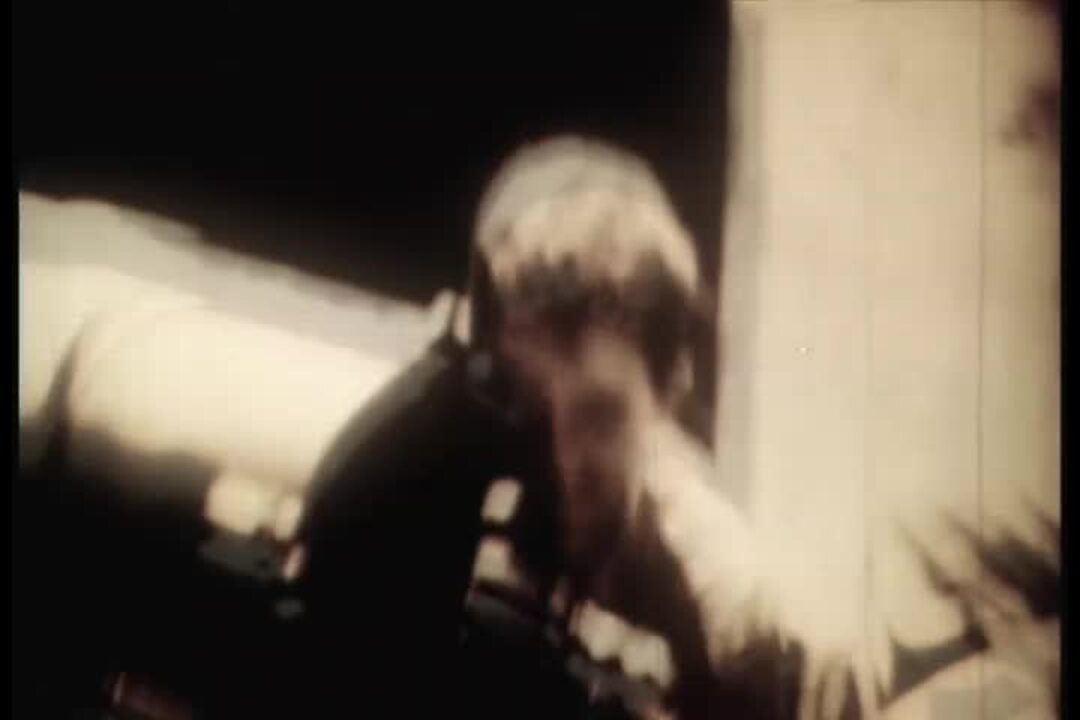
War and Peace (1942-1954)
War and Peace (1942-1954)
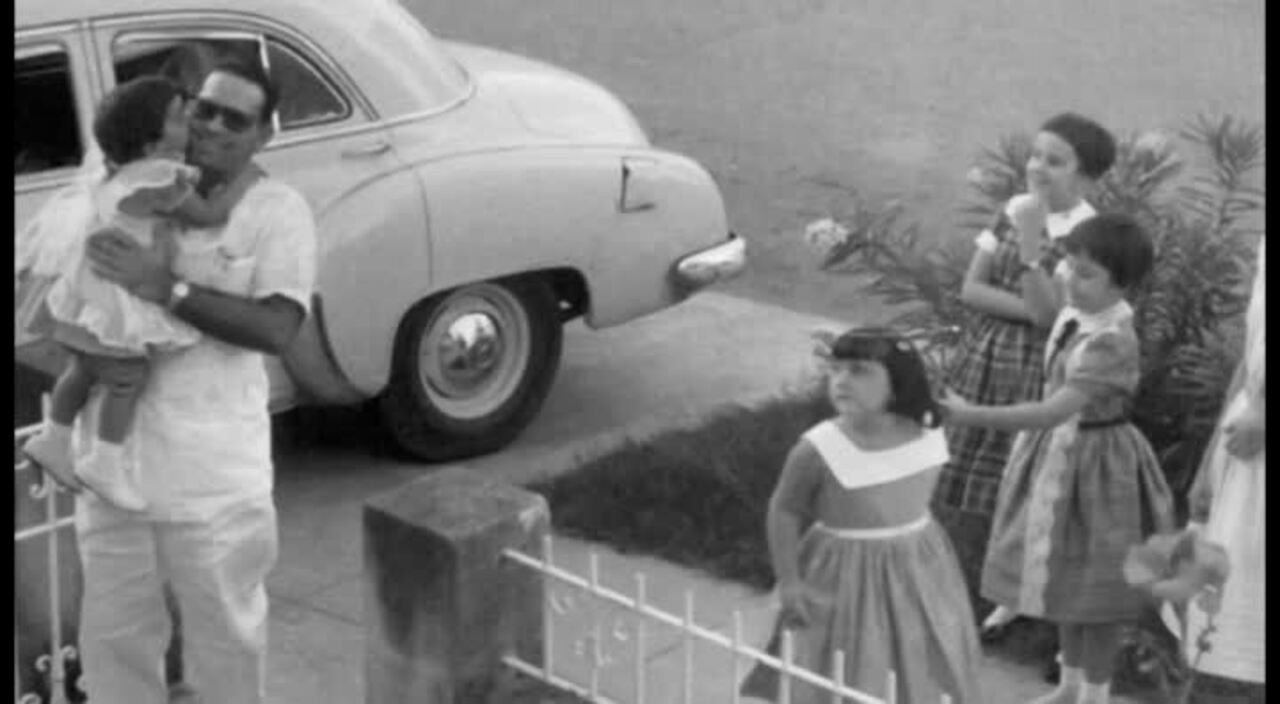
The New Latinos
The New Latinos
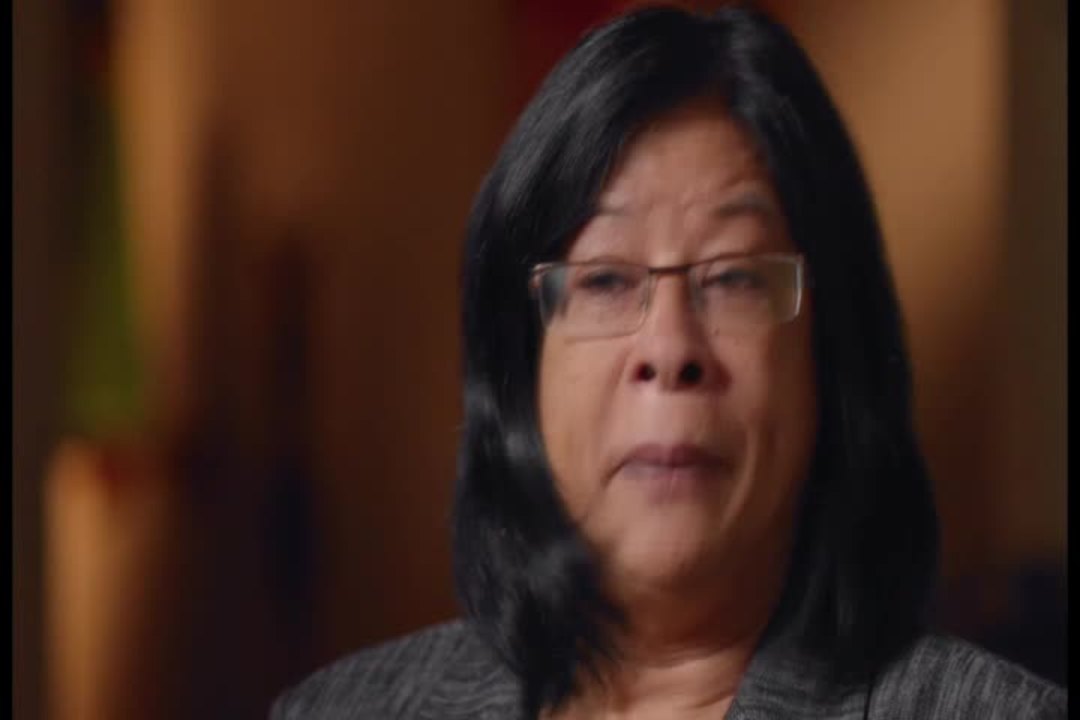
Prejudice and Pride (1965-1980)
Help everyone explore new worlds and ideas. Support your PBS station.
[ACOUSTIC GUITAR MUSIC]
In the 1940s, in Delano, California, as in most American towns, people lived segregated lives, even at the local movie house where whites sat in the middle, and everyone else sat on the sides. Then, one day, things changed.
In 1946, there was a young guy by the name of C.C. He was a pachuco, he was a zoot-suiter who went off to the Navy, came back, put on his civvies and went to the movies. And since he was serving his country, he felt that he had a right to say wherever he wanted. So he came and sat in the middle. He wouldn't move, so the police arrested him.
There was no law that said you couldn't sit in the middle, so they couldn't charge him with anything, not even disturbing the peace. He was pretty peaceful. So they grilled him for a couple hours, and then released him. And everybody noticed. They said, hey, C.C. got away with it. He was sat in the middle.
So the following week, everybody sat in the middle section. And the town movie house was desegregated. And that happened across the entire valley.
Some 20 years later, when I told my mom I was going back to Delano to work with the union, she says, oh, you're going to work with C.C. And I said, C.C.? Is that vato still around? And she says, mijo, don't you know who C.C. is? He's Cesar Chavez.
[CHUCKLES]
In the 1960s, Cesar Chavez would become the most significant Mexican American leader of his generation. He would join forces with Dolores Huerta to champion the human rights of some of America's poorest workers.
The workers were literally like slaves. The living conditions were horrendous, and the children were barefoot. And I thought, well, this is so wrong.
[PROTESTERS CHANTING]
Their success would ignite a movement challenging a long history of prejudice and injustice. In East Los Angeles, a high school teacher led the largest student walkout in history, risking his own freedom to give Mexican American students a chance at a quality education.
It was a risk. It was a gamble, but a gamble that had to be taken. We're trying to make schools better, trying to make the country better.
In Crystal City, Texas, a graduate student founded a political party, transforming centuries of oppression into ethnic power.
Reckless? Yes. Dangerous? Extremely. Did it pay off? Damn right.
And in San Antonio, a young activist brought millions of Mexican Americans who had never voted to the polls, eventually doubling the number of Latinos elected to political office.
Because of his will, his sheer will, we became a part of the American system.
During the 1960s and '70s, a whole generation of Mexican Americans discovered a new sense of pride as they fought for equality and challenged America to accept them on their own terms.
[HELICOPTER BLADES SLAPPING]
[CHAMBER FOLK MUSIC]
California's Central Valley, 23,000 acres of some of the most productive farmland on the planet. In the 1960s, while the agricultural companies that owned the land became wealthy, tens of thousands of farm laborers who worked the land remained desperately poor.
These were inhumane conditions. They were un-American conditions. There were conditions that relegated these farm workers to the lowest workers in the whole country.
Most were Mexican Americans who could neither read nor write. Most would die by the age of 49. And to most of the country, they were invisible.
Every time we sit at the table to have something to eat, the fruit and the vegetables got there because someone was exploited. They're subjected to the sun, and to the heat, and to the cold, and to pesticide poisoning. They're treated like animals. And they endure all the sacrifices and all the suffering so you can eat and I can eat. These men, and women, and children feed all of us, and they don't have any food for themselves. And we're going to change it. It's going to be changed.
Cesar Chavez was the second of six children, born into a devout Catholic family on a modest ranch in Yuma, Arizona. They lost the ranch during the Great Depression, and were soon forced to enter the backbreaking world of migrant labor. Traveling across California, taking whatever work they could find, the Chavez children passed through 37 schools in three years. Cesar dropped out at the age of 14 to work full time in the fields.
What was amazing about Cesar is that he was almost entirely and completely self-possessed. He never got past the eighth grade, and yet he was brilliant.
After a stint in the Navy, Chavez worked for the CSO, the Community Service Organization, a group dedicated to improving the lives of Mexican Americans. There he met someone who shared his passion for justice, a 28-year-old former schoolteacher from Stockton, California, Dolores Huerta.
In the school where I was teaching, there were a lot of malnutritioned children. So I went to my principal and I said, you know, these kids are obviously very hungry. You know, can I get a voucher for shoes, free lunch for these kids? And his response was, their parents, all they do is drink up all their money. I knew he was wrong.
A frustrated Huerta had quit her teaching job to join the CSO. At a meeting in San Francisco in 1962, Cesar Chavez approached her with an idea that would alter the course of their lives.
He said, you and I have to organize a union. And then he said, but we will not see a national union in our lifetime. And I said, why? He said, because the growers are too rich, they're too powerful, and they're too racist.
For Huerta, a divorced mother with seven children, committing herself to the farm worker cause was an agonizing decision.
And that was a big step for me because I had family that I had to support. And I remember just thinking about this, this is such a foolish thing to do. But I just remember, I've got to do this. And I did it.
But a serious obstacle stood in the way of creating a farm workers' union, the bracero program, a government initiative left over from World War II, that brought in Mexican laborers to replace Americans who were fighting overseas.
[BAND PLAYING MARCH]
This is the vanguard of 1,500 Mexicans brought to the state by the Farm Security Administration. Most are laborers, all of them are bachelors.
When the war ended, the program continued to bring in a nearly unlimited supply of cheap laborers from Mexico desperate for work. But once in the U.S., their employers could use them as strike-breakers, and have them deported if they complained.
They weren't allowed to organize into unions. The workers were literally like slaves.
The bracero program was finally ended in 1964, after 20 years of opposition by Mexican American leaders.
I was able to go to Washington, D.C. And Cesar and I worked together, working with Secretary of Labor. And we were able to end that program.
Now a viable union seemed possible.
[COMMOTION, TEAR GAS CANISTER FIRES]
But the history of unionism in the United States was scarred by violence. Since the 1930s, dozens of strikes had bloodied the streets and fields of California. Attacks in retaliation often triggered cycles of violence that robbed workers of public support and doomed the strikes to failure.
We knew that in the past history of organizing farm workers, that there had been a lot of violence. We knew farm workers had been killed.
[ACOUSTIC GUITAR MUSIC]
Chavez and Huerta admired Mahatma Gandhi, who had gained India's independence from England through a nonviolent campaign.
For both of them, nonviolence was not just a strategy. It was a principle of how to live your life, that if you believed in the principle of human dignity, you didn't harm another human being.
For three years, Chavez and Huerta signed up farm workers, gradually building their union. But in September 1965, they were caught off guard.
[INDISTINCT SPEECH]
Filipino grape workers near Delano, California went on strike, demanding higher wages.
Come into the fold of unionism, and help bring the agriculture worker into the fold of unionism.
We voted to support the Filipino workers. But we were very naive. We made these big old signs that said huelga, which means strike in Spanish. First day, we had a couple of strikers that were beaten up. And it was not a good experience.
(THROUGH MEGAPHONE) Don't be a traitor against your brother.
Here's this young woman, not that big, leading a struggle. And she was challenging the role of women among farm workers. They had never seen an aggressive, independent woman like Dolores.
Come on out, brothers. We are waiting for you. You are earning more money today, because the workers here went out on strike on September the 9th.
And I found myself in a position where I was willing to be a lieutenant, to be a follower.
[INDISTINCT SPEECH]
The strike unfolding in the San Joaquin Valley resonated with Valdez, an aspiring young playwright who'd grown up in Delano.
We were migrant farm workers. And so I was in the fields before I could walk. I was in my mother's arms. And like a lot of migrant kids, I used to sleep in a fruit box while she worked. And eventually, when I was old enough to walk, I began to work.
[SPANISH SPEECH] Engage in the conversation.
Valdez soon became part of Cesar Chavez's inner circle.
Venga.
Cesar was relatively young, but he was mesmerizing, I mean, his presence. And I'm not talking about something flashy. I'm talking about something very basic, very humble. But his sense of place and time, of what to do under the given circumstances, came from a confidence that he had within him. That confidence inspired all of us.
[PENSIVE GUITAR AND PIANO]
After four months the strike was going nowhere. Growers bussed in non-union workers to pick the grapes and break the strike. As the harvest wound down, the union was almost broke, and Chavez was losing hope.
In the crop season, there is a period where everything is germinating. The vines have been pruned, they've been de-leafed, it's been irrigated, and now you've got to wait for the new crop to kick in. And so there's the dead season, what the farm workers call invierno chiquito, the little winter.
That was a dangerous time for the union, because there are no workers in the field.
Chavez was beginning to believe the strike could never be won in the fields. He desperately wanted to bring the movement into the national spotlight.
Cesar came up with the idea of marching to Sacramento.
In the manner of Martin Luther King, who garnered media attention leading a march through Alabama in 1965, Chavez would lead a 300-mile pilgrimage from Delano to the state capital, passing through farm workers' towns along the way.
Cesar had said, it's going to be a march of penitence. And the workers said, well, we don't have anything to be penitent about. I mean, the growers are the ones that are doing everything wrong. And he said, no, no, I want everybody to think of something you've done, some gossip maybe, some fight that you had. Think of your own things in your own life.
It was a pilgrimage. This was a spiritual pilgrimage. It was an attempt to suggest to the workers and others, this was going to be a long struggle.
As he planned for the march, Chavez's faith was being tested. Striking workers were subjected to physical and verbal attacks from growers, who seemed to have law enforcement in their pocket.
[NON-ENGLISH SPEECH]
On March 16, 1966, with the situation threatening to explode, the Senate Subcommittee on Migratory Labor held hearings in Delano.
The fact that somebody makes a report about somebody going--
As news cameras rolled, Senator Robert Kennedy grilled the local sheriff on his practice of arresting peaceful demonstrators.
Who told you that they're going to riot?
The men right out in the field that they were talking to said, if you don't get them out of here, we're going to cut their hearts out. So rather than let them get cut, you remove the cause.
This is a most interesting concept, I think. How can you go arrest somebody if they haven't violated the law?
They're ready to violate the law. In other words--
[AUDIENCE LAUGHS, CRIES OUT IN REPROACH]
Could I suggest, in the luncheon period of time, that the sheriff and the district attorney read the Constitution of the United States.
The farm workers have suffered in our society over the period of the last 30 years. And that situation has to be changed.
[CHEERS]
[UPBEAT FOLK MUSIC]
Chavez set out the very next morning, along with 100 farm workers, to begin his pilgrimage through California's San Joaquin Valley.
Cesar, either by design or by accident, ended up becoming symbolic of the penance part because he had some boots that injured his feet. Turned out to be the worst idea for the march. He was visibly in anguish, which made for great pictures. You know, a living Cesar suffering on the road.
As they traveled north, passing through town after town, their numbers grew.
[GROUP OF MEN SINGING CHEERFULLY IN SPANISH]
As a Catholic, Chavez understood the power of symbols to instill a deep personal commitment to the movement and attract public attention. They flew the union eagle, a symbol of Mexican pride. And the Virgin of Guadalupe, the Virgin Mary as a brown-skinned Mexican Indian, signified for many the righteousness of what was now being called La Causa, the cause.
After 25 days, their numbers had swelled from a few dozen to an army of thousands. On Easter Sunday, 1966, the state capital was finally in sight.
When we got to Sacramento, there were 10,000 people marching across the Sacramento River with us, over the bridge. And it was people power. This was a demonstration of democracy.
(CHANTING) Huelga, huelga, huelga, huelga, huelga, huelga, huelga.
To the governor and the legislature of California, we say you cannot close your eyes and your ears to us any longer. You cannot pretend that we do not exist. You cannot plead ignorance to our problems, because we are here, and we are not alone.
[CHEERS]
With public sympathy mounting and the spring growing season upon them, growers finally agreed to meet with union representatives.
--farm workers of the state of California.
[CHEERS]
Dolores Huerta became the lead negotiator. And it was unprecedented, because here was a Mexican American woman negotiating with the growers and taking them on.
She is an excellent negotiator. She can break things down, and can also stand her ground on an intellectual level, and argue points, you know, with lawyers.
They hated her. They called her the dragon lady. They wished they were negotiating more with Cesar than with Dolores.
It would take years of negotiations and a national boycott for Huerta and Chavez to secure higher wages, safer working conditions, and an end to child labor. But the march to Sacramento was the turning point. It led to the first farm worker contracts in American history. And for Mexican Americans, it was only the beginning.
Viva la huelga.
[CHEERS, APPLAUSE]
The rise of Cesar Chavez as a national figure began a fundamental shift in Mexican American identity. Before Chavez, most Mexican American leaders came from upper-class families and tended to be light-skinned, European-looking, traits that were prized by many in the Latino community.
Our elders, you know, when there was a new baby, and they say, aye, que bonito, mira que chulo. Mira que ojos azules, que bonito. And then we'd hear, pobrecito, mira que indio salió. So, you know, they'd say, look at that pretty baby. It's got blue eyes. You know, it's so white, it's so pretty. And then the other baby, another cousin in the family, ah, too bad, man, he came out dark. He looks like an Indian. There was a self-hate that was embedded in that.
But after Cesar Chavez, some of those prejudices began to erode.
He had become pretty much a national icon. And we loved him because he dressed the part like we did-- no suit and tie, no Brylcreem, no aftershave, puro indio, soft-spoken, khaki pants and a flannel shirt, mixed blood. This is who we are. We are America.
[BLUESY LOUNGE MUSIC]
But in mid-1960s Los Angeles, the largest Latino community in the United States seemed destined to remain in society's underclass. 130,000 Mexican Americans were attending L.A. public schools, but their graduation rate was one of the lowest in the country. It had been that way for generations.
At Belmont High, Sal Castro, an East L.A. native, had landed a job teaching social studies. After only a few weeks, he noticed something about the student body that concerned him, and approached the principal.
I said, Mrs. Lord-- I still remember her name-- I said, Mrs. Lord, you know, there's a lot of Mexican kids here. They're not in student council. They're not participating in some of the academic programs. What's going on here?
She says, you know what, you know, the kids are participating. I says, no, ma'am, that's not true. You know, I'm concerned about this. Mr. Castro, she says, let me check. So then she calls me back, and she says, Mr. Castro, look, Mexicans have a very charming passivity. You wouldn't want to take that away from them, do you?
Castro was disheartened but hardly surprised. The situation in the school seemed all too familiar. When Sal was only 2, in 1935, his father had been forced to leave L.A. and return to Mexico, one of about half a million Mexicans and their US-born children deported during the Great Depression. The idea was that Mexicans were causing the Depression. People were out of work because of these goddamn Mexicans. So they started rounding Mexicans up. With his family divided, Castro spent his childhood going back and forth between Mexico and the U.S. before attending school in East Los Angeles.
As I came back up to the United States and started school here, I spoke mostly Spanish. And the teacher could not understand me, so I sat in the corner. They were even swatting kids for speaking Spanish. And worst of all, your parents spoke Spanish. Maybe there was something wrong with your parents. You know, that's really a psychological whipping that these folks did not understand. Or if they understood it, they didn't give a damn.
Now, as a teacher, Castro could see that little had changed. Most Mexican American students were directed away from academic classes and into vocational training.
When I was in high school, I was asked, what does your father do for a living? I said, well, he works with his hands, doing construction, cheap labor, pick-and-shovel kind of job. And she told me-- she was a white woman-- she told me, oh, that's a very honorable profession. You should follow in your father's footsteps.
I was told specifically in a geometry class, when I got up to ask a question, oh, Paula, why are you even bothering? We all know you're not going to go to college. You're going to be pregnant by the end of summer like the rest of your girlfriends.
Every year, about half of all Mexican American students in Los Angeles schools dropped out. Barely one in 1,000 attained a college degree. Castro set out to transform these dire statistics by instilling in his students a sense of pride.
He made me feel like loving Mexican culture and our own heritage was actually cool. And that was both unsettling, and revolutionary, and exciting.
As students learned about Mexican American history and the indigenous roots of their culture, many began adopting a new name for themselves-- Chicano.
When we identified with the word Chicano, our understanding of the word was that it was the same word that is the root word for Mexico, which was the name of the Aztec Indians. And their name was Mexica. That's what the Spaniards called them, Mexica. And you drop off that weak first syllable, "meh," and you get "shee-kah," and that becomes Chicano, "Meh-Chicano," and that's who we were.
With this new awareness of identity came a heightened sense of self-worth which Sal Castro reinforced.
What he was able to do with his students was to give them a sense that they weren't the problem, it was the schools that were the problem. And when they began to understand that, and the dialogue they would have Sal, both in and out of classrooms, that empowered them.
So we started to get that there was something wrong. And we were looking at the African American civil rights movement. And we understood that it wasn't their civil rights movement, it was a civil rights movement. It included everybody.
[FOLK MUSIC]
By 1967, with Martin Luther King organizing in the South and Cesar Chavez organizing in California, Sal Castro began looking for ways to organize students in East L.A.
I went to see my father. And I said, what do you think, Dad, what do think I should do? He says, huelga, mijo. Huelga-- that's all he said.
Castro determined to organize a huelga, a student strike of as many schools as possible. Students drew up a list of demands that included having classes in Mexican American history and hiring more Latino teachers. Castro enlisted recent graduates to help.
He said, there's kids today in the schools that I'm teaching, that are going through the same experience that you guys did, that I did, he said. And I want your help to bring it to a stop.
The word started to circulate-- walkout, walkout, let's boycott school. And we slowly planned this out, campus by campus, over a six-month period. And we set a date, March the 6th, 1968.
I was scared, excited, nervous. My mother told me, I'll meet you in front of school. Look for me. So that really empowered me.
And I got to Lincoln High School and. I knew that others were at Roosevelt-- we had all coordinated, and others were Garfield, and some were at Wilson. Belmont was ready as well.
I remember being really nervous, and not knowing, can I do this? What if I'm the only one who gets up and does this? Can I really do this?
And you know, the time came, 10 o'clock. I rushed onto the campus, and nobody was walking out. And I started yelling, up and down the hallways, walkout, walkout, walkout.
I stood up and walked out of the classroom. I was afraid to look behind me to see if anyone else was coming.
And then the doors started to fling open. And the students just rushed out.
[UPLIFTING MUSIC]
The roar of their footsteps all coming down the stairwell where I was, that was exciting.
[CHEERS, LIVELY TALKING]
All I remembered was, OK, I gotta go to the front gate because that's where Mom is. And there she was. As all of the students came out, I picketed Lincoln High School with my mother.
Over 1,000 kids were out there. And the more we marched-- I was in the front-- we looked back, and wow, look at all these kids. And parents coming out and joining them.
It was a very emotional time for me. Damn, it was beautiful.
By the end of the day, March 6, 1968, some 10,000 students had peacefully walked out of four East Los Angeles high schools. But tensions were high in the city. Race riots had erupted all across America the year before. And when students at Roosevelt High School walked out, police officers were sent to maintain order. Things soon got out of hand.
(THROUGH MEGAPHONE) --to disperse immediately.
The next thing we knew, the police started rushing us. And they were waving their billy clubs. And it was as ugly as I remember in my life-- people being clubbed down to the floor because they wanted an education.
The next day, we walked out again. And we walked out again the next day after that. And we didn't stop for two weeks.
We are not going to--
The walkouts eventually led to meetings with parents and administrators, and many of the students' demands were met.
You started having brown faces. You started having more Mexican administrators, more bilingual administrators. And sure enough, we eventually started having superintendents.
The decade of the 1970s would see more Latinos attending colleges and universities across the country than ever before. And they would eventually establish Chicano and Latino studies departments at over 160 universities. But perhaps the greatest transformation took place within the students themselves.
Before the walkouts, the word Chicano didn't have the charge of claiming our identity in the country, and saying, yeah, I'm an American, and that means being a Chicano. After the walkouts, being Chicano meant that you were going to stand up for who you were, and own it.
[FOLK MUSIC]
All across the country, Chicanos were taking ownership of their future.
We came here to build the new Chicano movement. That's what we came here for.
In Colorado, Rodolfo 'Corky' Gonzales organized the first-ever Chicano youth conference. 1,500 young people rallied to support Chicanos running for office, to demand equal rights for women, and to press for more community involvement in public schools.
In Washington, D.C., the National Council of La Raza became the largest Latino organization in the country fighting for civil rights.
Although we are fighting for land, we are fighting for the survival and protection of our culture.
In New Mexico, Reies Lopez Tijerina led a movement demanding justice for the descendants of Mexican Americans whose lands had been taken following the U.S.-Mexico War of 1848.
[CHANTING] Huelga, huelga, huelga--
In California, the farm workers' union would grow to over 70,000 members. And their gains in wages and working conditions had enabled many to leave the migrant trail. And in San Antonio, Texas, young Chicanos frustrated with the slow pace of social change were challenging the political status quo, as represented by Congressman Henry Barbosa González.
He was the first member of Congress from Texas who was Mexican American. We all looked up to him. And he was fine at the beginning.
Back in 1956, González, known to all as Henry B., had become a beacon of hope and change for Mexican Americans with his election to the all-Anglo Texas state senate. He soon took on the Texas establishment in a crucial battle over school integration.
In 1954, the Supreme Court passes the Brown versus Board decision, declaring that school segregation is unconstitutional. Well, there was a serious backlash from Southerners, and Texas included.
The state was in flames about integrating schools.
Texas governor Price Daniel introduced nearly a dozen bills intended to preserve segregation. Henry B. González determined to stop them by staging a filibuster in the Senate.
He just talked all night. And with nobody else there to hear it, he was saying, who speaks for the black man, who speaks for the Mexican American? For whom does the bell toll? It tolls for thee.
[EXHALES SHARPLY]
González spoke for a record-breaking 22 straight hours.
Henry B. effectively derailed most of the bills. And he became immediately a hero to the African American and Mexican American population of Texas.
[BRASS BAND PLAYING]
González grew up middle class, in a mixed-race neighborhood near San Antonio's downtown. His parents fled Mexico for Texas during the Revolution of 1911. They came well educated, with more schooling than most Americans.
My grandfather, Leonidas González, was actually the mayor of a small city. His brother was a doctor. You could say they were representative of a certain segment of society that truly had-- were very accomplished, and in many ways privileged.
Dad was brought up with the arts and literature and music.
In 1961, González broke another barrier, becoming the first Mexican American from Texas to win a seat in the U.S. House of Representatives. Almost immediately, he began promoting a World's Fair to celebrate the 250th birthday of San Antonio, and bring new jobs and tourism to his city.
This is a tribute to the people of San Antonio. Our hopes, our aspirations are wrapped up in the successful HemisFair in 1968.
Don't miss the travel highlight of the year. Come join the fun at the San Antonio World's Fair, now in America's Fiesta City.
[SPARE, REVERB-LADEN WESTERN GUITAR]
But just a few miles away, San Antonio's West Side was no fiesta city. Henry B. González's efforts to boost the local economy were not trickling down to the barrio, where many of San Antonio's 350,000 Mexican Americans lived in some of the worst slums in the nation.
The living conditions for Mexican Americans in San Antonio were dire. The homes were pieced together with scraps of metal, wood. In some places you had shotgun houses arranged around a little courtyard, with one faucet, one outdoor privy. Those were the conditions in San Antonio.
By 1968, many Chicanos saw Henry B. as out of touch, more connected to Washington power brokers than to San Antonio's poor.
Henry B. González, by this time, was seen by many to have compromised his earlier ideals. Many Chicanos were pointing out the glaring inequities in the city. And the cry from the Chicano community-- or the activist community is, where is Henry B. González? Where is Henry B. González?
[SHOUTING]
Just days after the grand opening of HemisFair, Chicano high school students, like their Los Angeles counterparts, staged walkouts, first in San Antonio, then in 39 towns across Texas. Eventually they spread to nearly 100 high schools in 10 states.
The mastermind behind much of this activism was José à Gutiérrez, son of a local doctor, and a graduate student in political science from a small town southwest of San Antonio called Crystal City.
[ACOUSTIC BLUES]
Crystal City, where I grew up, was simply like an old colonial plantation. It was a segregated town. Anglos had paved streets, sidewalks, lights. We had none of that. Polio was rampant, tuberculosis was rampant. Everything around you was just simply disheartening.
Like many south Texas towns, Crystal City had been shaped by racial violence, much of it perpetrated by the Texas Rangers, a 150-year-old autonomous police force, with a history of intimidating, even killing Mexicans. As a young boy, Gutiérrez often witnessed the aftermath of this brutality.
My father's medical practice was in our home. And it would not be unusual for us, at night-- middle of the night-- to hear a thumping on the door, and there's a body. They would've been pistol-whipped, or they had been beaten by the police.
The police department at the time was just about 100% Anglo. And they pretty much enforced, you know, whatever the ruling class needed to have enforced. Gutiérrez blamed gringos, the Anglo authorities in South Texas, for keeping Mexican Americans down. He was determined to help Chicanos gain political power.
We recognize that the barriers to our integrating into the society and to uplifting ourselves is the gringo, the gringo who's put the barriers, who makes us drop out of school, who keeps us in bad health, who doesn't pay us good wages, who prohibits our unions, and so on, and so on, and so on. So until we get rid of those elements, we're not going to progress, we're not going to be free. So yes, the gringo must go.
This press conference became known as the "kill the gringo" press conference, because that's the way the newspapers portrayed it. But what José Ãngel Gutiérrez meant was kill the gringo supremacy, not the individual, but the system. In a television interview, Henry B. González denounced Chicano activists like Gutiérrez in what he called their campaign of hate.
I picture my own role as having a responsibility to smoke out and to expose these false and mistaken voices of hatred. I feel that I fought against those in the majority who were preaching the same hatred 12 years ago in a different context, that I have the same responsibility to expose it among the minority, even if it is the minority from which I emerge.
Henry B. González, in my estimation, had a view of America that bought into the melting pot scenario. And our movement said, no, we reject that. We don't have to give up our language, we don't have to give up our culture, the extended family, all those things that make us who we are. We're not going to erase those just to buy into your notion of what it is to be an American.
[BLUESY LOUNGE MUSIC]
Back in his hometown of Crystal City, Gutiérrez organized yet another high school walkout. After eight long weeks, the students won their demands. But that was not enough for Gutiérrez.
In the school walkout, you have to go back the next day, once you settle, to the same teacher, the same principal, the same superintendent, same school board. Well, the only way to change it is to have a political revolution electorally, vote them out of office so that then you can hire the correct principal, and superintendent, and so on.
If we can take over a school, and be successful, and get what the students and their parents want, why can't we just become a county commissioner? Why can't we become the sheriff. Why don't we become the county judge?
So we formed a political party.
They called their new party La Raza Unida, the united people. Gutiérrez spent weeks going door to door encouraging Mexican Americans, who made up 80% of the population, to run candidates in the upcoming elections.
[SPANISH SPEECH]
When you saw José Ãngel Gutiérrez walk into a Crystal City barrio, he knew how to talk to people. He could speak to our grandmothers, he could speak to our mother, to our uncle, to our father. And he could articulate their concerns. He was very committed to the poor, to the working class. He understood their needs. He knew how to organize people.
Now we're going beyond high school walkouts. Now we're really going to take on the system here.
We fielded 16 candidates in three counties and won 15, school boards and city council.
The elections in April of 1970 saw an unprecedented victory for Chicanos. Gutiérrez was elected county judge, and La Raza Unida now controlled not only the school board, but city and county government as well. Before you knew it, we had Chicano teachers, and principals, and superintendents. I mean, this was just incredible. You know, you walked into the county courthouse, and you would smell chorizo.
[CHUCKLES]
And we'd be speaking in Spanish in the courtroom, and tell the Anglo lawyer, you need an interpreter. And of course the Anglo Texans are beside themselves. They're thinking that this is a real revolution. Except that all that is happening is that Mexican Americans are exercising their political will.
La Raza Unida would grow into a national party, running candidates from California to Michigan as Chicanos began flexing their political muscle.
[BLUES FUSION MUSIC]
And in the largest demonstration of Chicano solidarity ever seen in the U.S., on the morning of August 29, 1970, over 30,000 took to the streets of East Los Angeles, demanding an end to the war in Vietnam.
The war was really becoming such a heavy presence in our lives that no one could ignore it. At that time, we were about 6% of the population in the country, and 20% of the casualties in Vietnam.
As I recall, there were miles of people marching down Whittier Boulevard. And we had this great celebration.
Marchers, including their families, gathered to enjoy speeches, dancing, and music. But authorities were on edge. Anti-war demonstrations across the country had often turned violent. And when police were summoned to a local liquor store after the alleged theft of a six-pack, the nearly all-Anglo sheriff's department arrived in riot gear, prepared to break up the demonstration.
And then tear gas was being thrown at us. And then people started running in all directions. And then I saw the police rushing us, knocking people down. And then people were picking up the tear gas and throwing it back at them. And we didn't know what was going on and why it happened.
[COMMOTION]
I saw a policeman coming up behind a young woman, and with a baton, hitting her in the back of the neck, and watching her drop like a rag doll. No one was ever held accountable for that.
[SOLEMN ELECTRIC GUITAR]
Three people were killed that afternoon, including Ruben Salazar, a reporter for the Los Angeles Times, who had often been critical of law enforcement in the Mexican community. Salazar was one of the few Latinos in the country who worked in the mainstream press.
We lost some of our heart. We couldn't understand why people had to die so that we could be Americans.
The ugly end to the demonstration seemed to knock the wind out of the Chicano political movements of the late 1960s and early '70s. La Raza Unida had few successes outside of South Texas. Torn by infighting, and under pressure from the political establishment, the party eventually disbanded.
Reies Lopez Tijerina's fight to reclaim land for Mexican Americans got him two years in federal prison. He and 20 armed followers had attempted to stage a citizen's arrest of the district attorney, and free eight of Tijerina's men from the county courthouse, who they believed had wrongly been jailed. Two officers were shot. Tijerina triggered the largest manhunt in the history of New Mexico when he fled into the mountains. After a week, he surrendered in Albuquerque.
[OBOE, GUITAR, AND PIANO PLAYING SWEETLY]
And Sal Castro, the hero of the L.A. walkouts, was arrested along with 12 others. The authorities had pushed back hard, charging the so-called L.A. 13 with multiple counts of conspiracy. It took two years of community protest and legal wrangling for the charges to be dismissed.
But after those turbulent years, the Chicano movement would take on a different tone.
[ACOUSTIC GUITAR MUSIC]
In Texas, Chicano activist Willie Velásquez, frustrated with both Henry González's politics of gradualism and the militancy of José Ãngel Gutiérrez, sought another way for Latinos to enter the political mainstream.
Everybody is looking for a third way here, or an alternative way. And I think Willie found one. On the face of it, it is very simple. You just organize and register voters, right? That's it. You know, I said, how can you build political power like that? Well, he was doing that in every town.
I remember hearing him give speeches on voter registration. And the people would jump up and start applauding and screaming. Because he got people excited about getting registered to vote. I've never seen anything like it.
[SPARE, REVERB-LADEN WESTERN GUITAR]
Willie Velásquez grew up on San Antonio's West Side, in the heart of the barrio. There were no sidewalks, no drainage for the winter downpours that regularly flooded the Mexican part of town, including the Velásquez home. In 1966, Velásquez became the first in his family to graduate from college. While volunteering with the farm workers that summer, he realized nothing would change in the barrio until Chicanos harnessed the power of their numbers. By 1974, Velásquez had found his calling, organizing thousands of voter registration drives across the southwest.
He was enormously successful. Nobody had marshaled the resources, the expertise, the technology of voter registration like Willie Velásquez did.
And there are some elections, and some of the people he registers to vote ask him, Willie, why didn't we win? We're all registered. So then it became very painfully clear to Willie that it was the system. It was the electoral political system of the state of Texas that was totally against them ever winning.
The system is stacked against us with gerrymandering. The way they have districts cut up that they divide a neighborhood where there's concentration of Chicanos into little pieces. And we are never going to be able to win that way. So one of the things that we're going to have to do is we're going to have to take people to court.
[STIRRING STRING MUSIC]
In town after town, Velásquez documented abuses, and began filing voting rights lawsuits.
They never lost a case. 85 voting rights cases. They never lost a case.
It wasn't that we were great lawyers, it's just that the law was so obvious and the violations were so clear. And the results were so directly connected to changing the election system, changing the way the game was played, that once you changed it and people participated, people started getting elected.
Velásquez was consumed with court cases and registration drives, pushing himself to the point of exhaustion, even though he was often ill.
He never went to the doctor to have himself checked out. Instead, he just kept taking Pepto-Bismol to get through whatever pain he was he was going through. But he had-- when finally he couldn't take it anymore.
[SOMBER PIANO MUSIC]
Velásquez was diagnosed with kidney cancer in May 1988. In six weeks, he was dead.
He died at 44. I mean, 44. We lost somebody that was basically a genius organizer, that's the way I would put it.
Willie Velásquez was posthumously honored with the Presidential Medal of Freedom, the highest civilian peacetime award a U.S. president can bestow. No person in modern America who has run for public office wherever Hispanic Americans live has failed to feel the hand of Willie Velásquez. He made this a greater country.
[UPBEAT FOLK MUSIC]
The world changed for us in a way that now you can see it. There are United States senators that are Latino. You can see that there are governors, you can see mayors, you can see figures that are now leading many institutions. This is a beautiful flowering that came out of the Chicano movement.
And what that said was, we were not foreigners. This is our homeland, which we understood was the United States of America, where we all belong.
[LILTING PIANO, GUITAR, AND HAND PERCUSSION]
Prejudice and Pride (1965-1980)
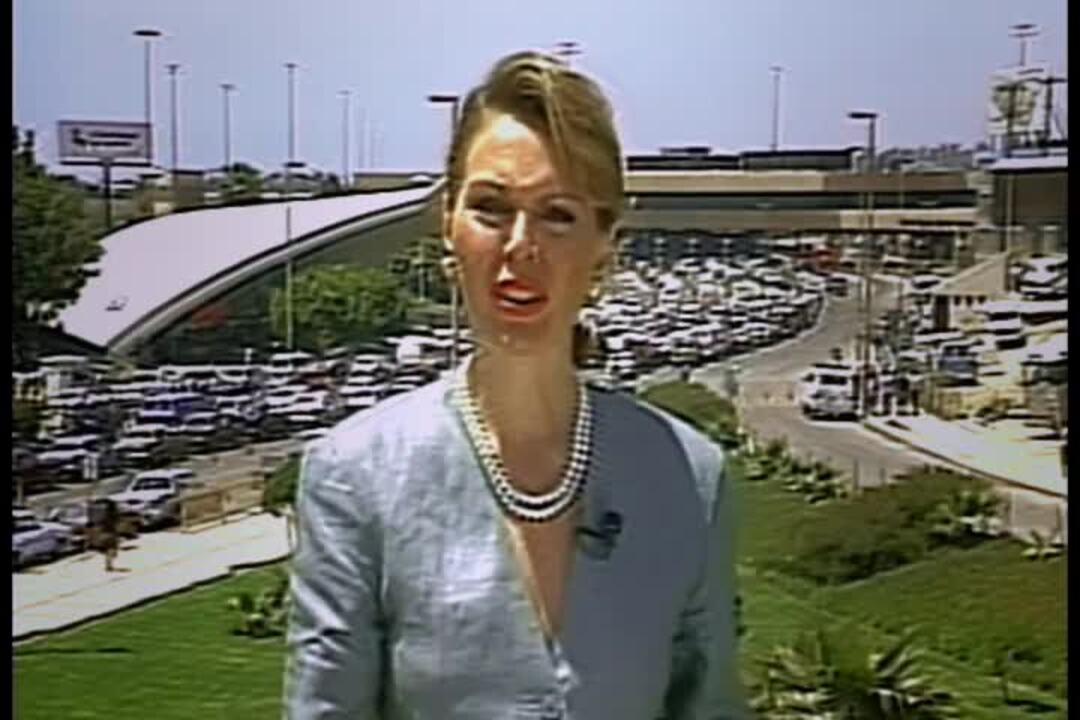
Peril and Promise (1980-2000)
Peril and Promise (1980-2000)
You might also be interested in…
What Is Our Obligation To Asylum Seekers?
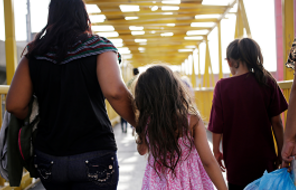
Current Events in the Classroom
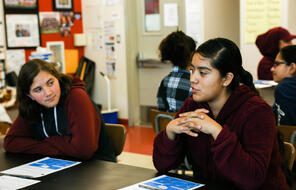
Haitian Migrants at the US–Mexico Border
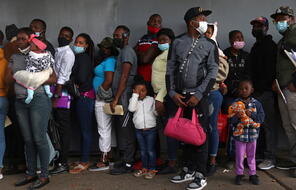
Resources for Civic Education in California

Resources for Civic Education in Massachusetts

Discussing Contemporary Islamophobia in the Classroom

Exploring Islamophobic Tropes

Addressing Islamophobia in the Media

Understanding Gendered Islamophobia

Standing Up Against Contemporary Islamophobia
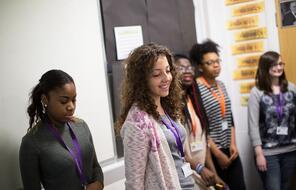
Why Do People Migrate?
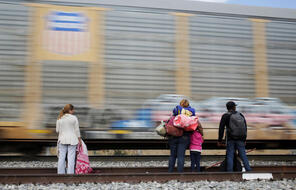
Different Perspectives on Migrant Detention
